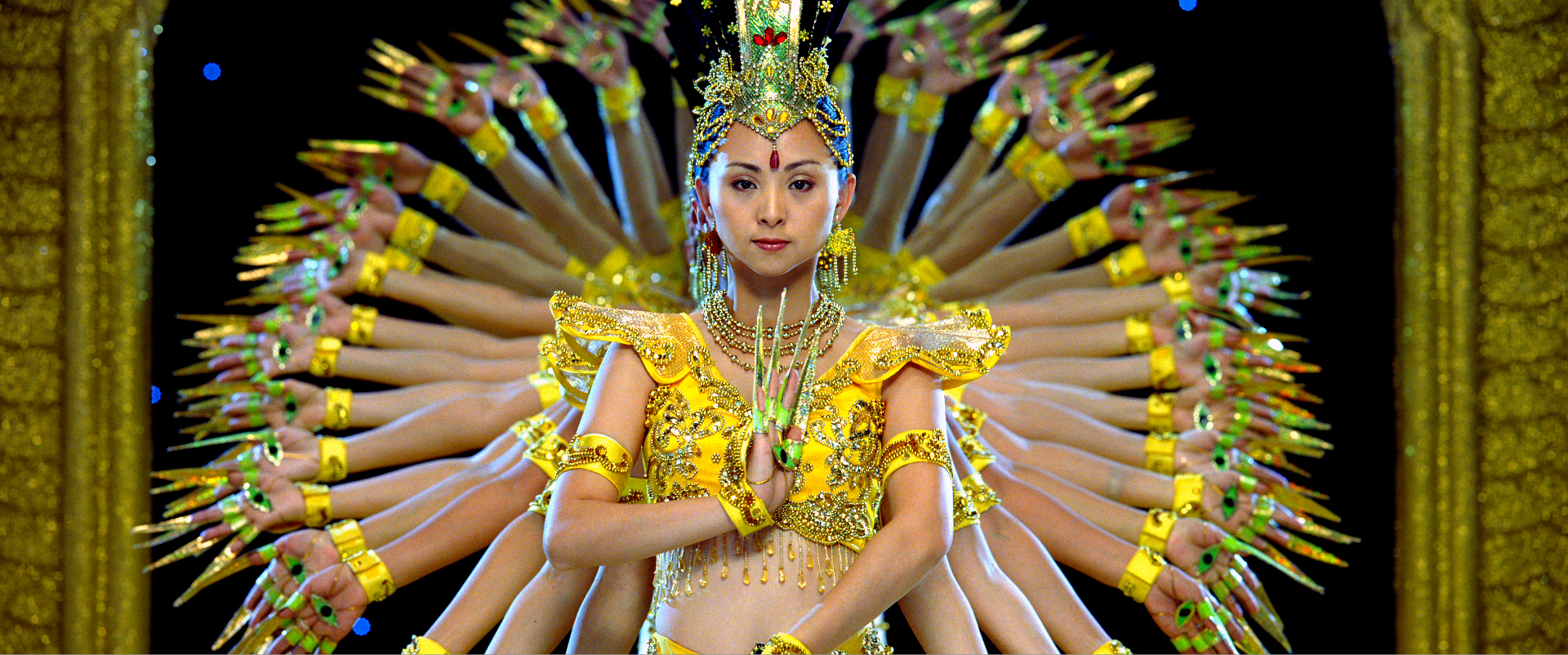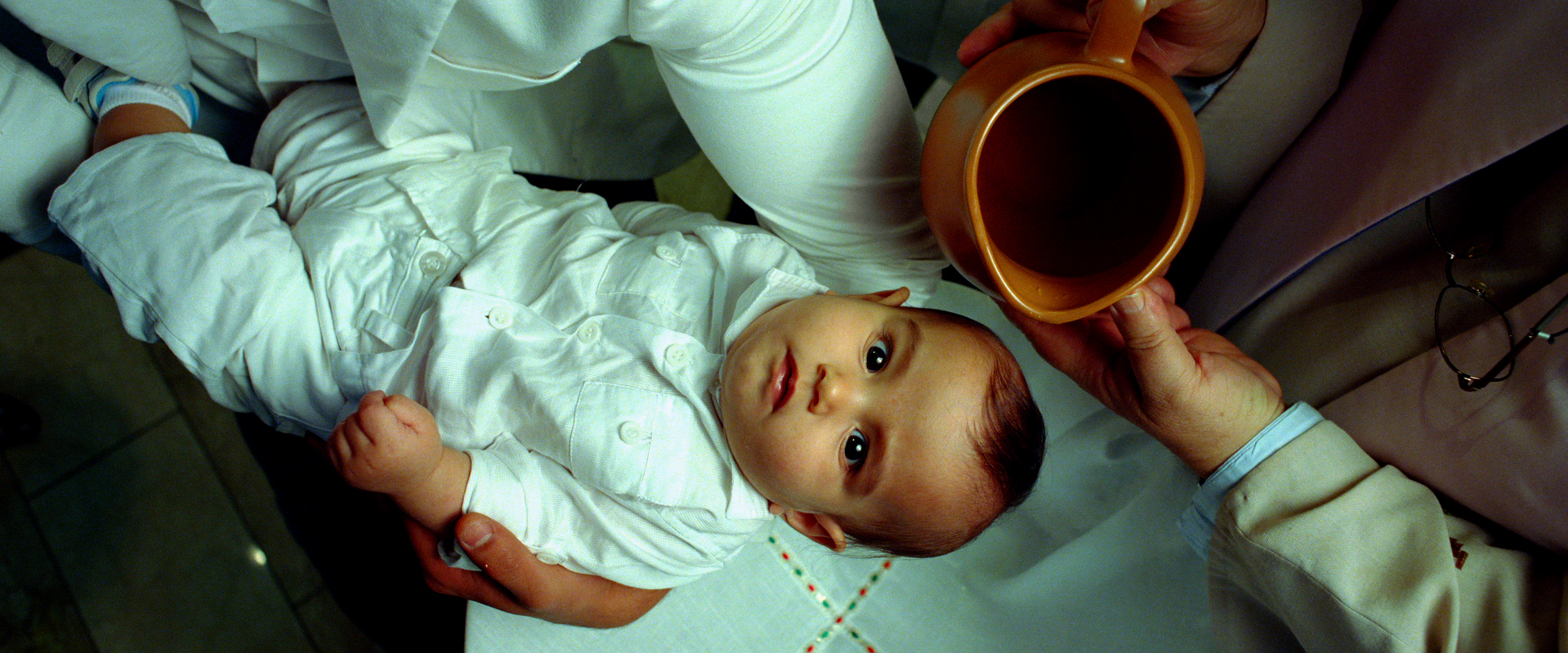Edwardina Scissorhands? Dancers do a 1,000-hand dance in a scene from “Samsara”
All photos courtesy of Oscilloscope/Ron Fricke
Pall bearers hoist a giant rifle – the deceased’s bizarre coffin — through a graveyard. This solemn visual joke comments on cultural choices, and demonstrates how far director Ron Fricke has traveled rhetorically. He globetrots to film sense-gorging wordless cinematic symphonies, documenting humanity’s oft-dubious role in the ineffable spectacle of earth’s glories, wonders and destructiveness. With Samsara (Sanskrit for “ever turning wheel of life”) he demonstrates the shrewdness of tracing life’s comic intertwining with the myriad turns of fate. Deft irony may make this the hit this subgenre seems almost too pure enjoy.
If you’re new to Fricke’s art documentaries, be prepared to go without a soothing, handholding narrator voice, or subtitles indicating the locations or the events depicted. Some people find the lack of context in Fricke’s film’s occasionally frustrating. Fricke explains that the free-floating effect was intentional. “It’s not where you are or why that’s important, it’s what’s there,” Fricke said in an interview feature about his previous film Baraka, which fully asserted his feature-length stamp on this genre. “I think it’s about reconnecting and communicating on a level that I think is necessary.”
And yet there’s a certain form and echoing of subject and themes in Samsara, which ends with the same images it opens with. One might try a Zen or meditative approach to viewing. As a person who has practiced TM off and on through his adult life, I’ve never found meditation more fascinating and stimulating than Samsara.
We may be spoiled by high-grade cinematography today. But Fricke pushes the standards to extraordinary heights with rarely-used 77-mm film and a custom-built camera specially designed for both fast and slow time-lapse, which the director uses to wizardly effect, a sort of blend of Charlie Chaplin and Claude Monet. There are no other evident special effects, so it’s pure film-making in that sense. The images were transferred through the highest resolution scanning process available to the new 4K digital projection format which allows for sometimes-mesmerizing images of unprecedented clarity. As the director says, the main character is the locations — this often breathtaking movie is meant for immersion in the darkened theater experience.
This spectacular Bollywood-style scene from a choreographed martial arts exercise shows the director Ron Fricke’s gratifying wit and light touch in Samsara.
Fricke contributed greatly to the creation of this a visual-intense style of storytelling when he did the cinematography for in Koyaanisqatsi in 1982 and then began directing and continued the wordless genre with Chronos (1985) and Baraka (1992), in collaboration with producer Mark Magidson, who also co-created Samsara.
Koyaanisqatsi, directed by Godfrey Reggio, employed a soundtrack of music by Philip Glass, but Fricke’s own projects have used Michael Stearns, one the most imaginative and talented composers in the so-called New Age genre, and actually a more enterprising and resourceful soundtrack composer than Glass. Stearns ingeniously and powerfully draws on field recordings of indigenous musicians and singers among the 25 countries visited and filmed over five years. At times, Stearns will layer disparate recordings together into what he calls a “world orchestra” effect, creating massive sonic chromaticisms.
Fricke differs from Reggio in that he does not overtly proselytize about technology’s deleterious effects on the planet (Koyaanisqatsi, means “Life out of Balance”). And especially in the new film, Fricke’s wit and humor consciously offset any morose solemnity, as troubling and heartbreaking as some images are, especially of the poverty stricken. So one wonders about the motivations to undertake a project so ambitious, risky and seemingly uncompromising.
“It’s very grueling working seven days a week” and driving and small plane driving conditions were often are dangerous, says producer Magidson.
Adds Fricke: “I would say we all almost got killed the on this project,” he said referring to the Baraka project. You get a little bit of a sense of the mountaineer’s “because it’s there” philosophy.
And you quickly get a sense of where Fricke’s anthro-sociological sympathies lie. The film opens with tight opening shots of three gaily made-up Asian female dancers wearing impish smirks, their heads twitching robotically.
A correlative shot quickly ensues — a close-up of a baboon sitting in water up to its neck, simply looking around. A highly sentient, human-like consciousness dwells vividly in his relaxed, roaming eyes, demonstrating how close we are to the higher primates. With his pointed, golden beard, the ape looks as much a shaman as a simian.
“I really believe we are connected to everything,” Fricke has said. “In a sense I’ve been invited to this planet like everybody else has. Life didn’t ask anybody to be on this guest list.”
“Invited to this planet” (in director Ron Fricke’s words), this child is about to be baptised
in Samsara.
Notice how that comment subtly conveys some of the paradoxical nature of existence, and that’s evident also in this film. He often shifts from enchanting to shocking in the blink of an eye. And his sense of visual rhythm often rides repeated patterns of activity — and surprises — as in his visits to various types of manufacturing plants: from a jittery, high-pressure clothes-iron assembly line to a coolly antiseptic sex-doll factory. We visit several meat and poultry processing centers, and the filmmaker’s avoidance of grisliness and his choreographic musicality sustain his high overall aesthetic, while providing enough pause, to perhaps push a number of borderline vegetarians to sprouts forever.
Previously Fricke has said his work was based on “humanity’s relationship to the eternal.” And for all the droll and puckish moments, that theme returns here. So we encounter exquisite and stately marvels of religious architecture and rituals, a virtual panoply of the human hunger for sacred sustenance.
Because the locations are the characters, two might be brethren misbegotten by Mother Earth; call them Spiritual and Capitalist Lemmings. See how the rise-and-bow supplication of thousands at an Islamic temple somehow echoes the stop-start spurts of rush-hour freeway traffic — the urgency and the uncertainty, the commingling of banal and transcendent yearning, which only such filmmaking can capture.
Samsara, rated PG-13, opens on Friday (Oct. 12) in Milwaukee at Landmark Downer Theatre, and at Sundance Cinema in Madison, and is showing nationwide into December.
Website: http://www.barakasamsara.com
A brief version of this review runs in the Oct. 10 issue of Shepherd Express.
this and photography
However, the DVD version includes a short behind-the-scenes featurette in which cinematographer Ron camera they built the main character is the location in essence that comes out of those images.
There’s not a more aesthetic format than widescreen 70 producer.
(Kevin Lynch)
which began when he filmed Koyaanisqatsi in 1982.
the gun barrel leading the procession fatefully.
The meat processing scenes veil grisliness with wit and artful choreography, yet still may inspire new vegetarians.
These visual and musical meditations aim for one’s nonverbal consciousness.
The dazzling 70-mm film aspires to invoke inward moral reflection as it carries us outward to the furthest reaches of humanity’s pan-cultural environmental footprint, a clownish stumble as much as an artful dance.
Some people find the lack of context in Baraka occasionally frustrating, not knowing where a section was filmed, or the meaning of the ritual taking place. However, the DVD version includes a short behind-the-scenes featurette in which cinematographer Ron Fricke explains that the effect was intentional. “It’s not where you are that’s important, it’s what’s there.”




